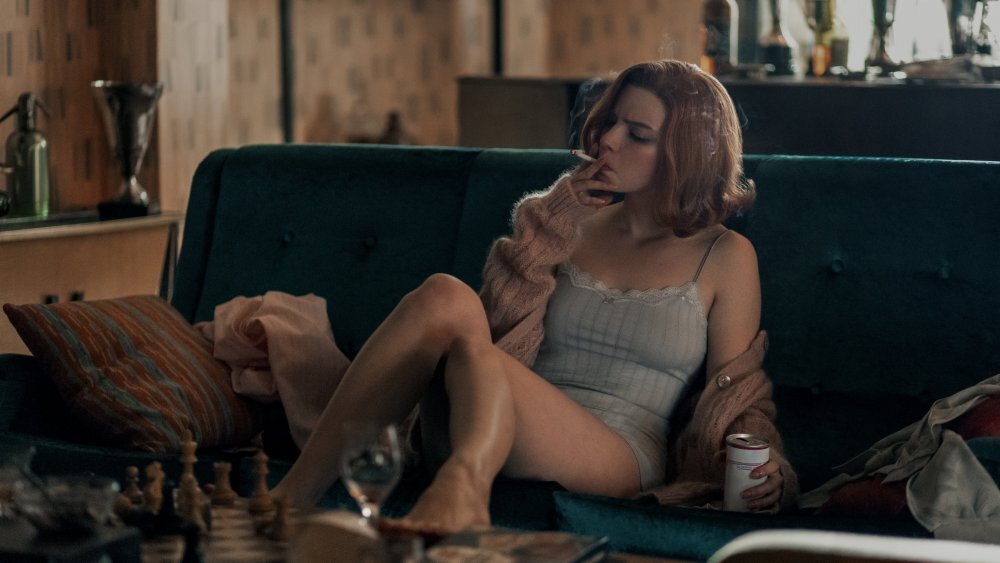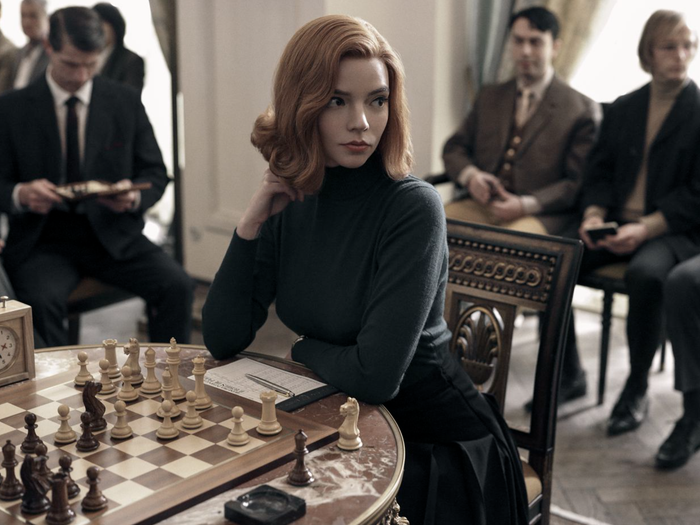On Screen: Analyzing the Male Gaze Present in ‘the Queen’s Gambit’
By Dhara Patel
It takes time and effort to learn how to recognize the male gaze in film and television, simply because it has been consistently ingrained in cinematic culture from the inception of filmmaking. Almost ninety-five percent of all films produced have been by white men, and thus, the male gaze is part of the global cinematic language.
The male gaze is in your everyday binge, pull up your queue and you’d be surprised. An example of the perpetuation of the male gaze lies within The Queen’s Gambit, a cinematographically stunning insight into the Cold War era. This Netflix limited series follows Beth Harmon, a prodigious young woman who attempts to enter the male-dominated sphere of competitive chess. Critics have raved, not only about the unique storyline or about the beautiful art direction, but about the show’s non-didactic approach-- instead of explicitly introducing and developing a message for the audience to take away, the creators, Scott Frank and Allan Scott, unfold a complex storyline where the audience is allowed to take away from the series what they most relate to. As a young woman hoping to make a mark in both the male-dominated industries of medicine and film, I, as well as a majority of the show’s audience, began to personally connect with Harmon’s rebellion against gender conventions. But, as the series progresses, the character of Beth Harmon transforms from being a feminist icon to an evident depiction of the blatant misrepresentation that occurs when female creators are excluded from the creative process. Instead of The Queen’s Gambit resonating with me as an empowering piece, I was left with the gross feelings of the male gaze.
Beth Harmon begins her chess journey as an orphan at the Methuen Home. It is in the Methuen Home where Beth begins to struggle with addiction due to the teachers passing out daily heavy-dose tranquilizers disguised as vitamins. Harmon quickly becomes seriously addicted as she believes that these tranquilizers help her visualize chess moves better, and she spends the first decade and a half of her life battling addiction, her own lofty expectations of herself regarding chess, and the neglectful parenting that occurs once she does get adopted. As she grows older and competes at higher and higher levels, Harmon accepts nothing but perfection and because of this pressure, just after quitting the tranquilizers, she replaces her previous addiction with the new vice of alcohol to cope.
As Harmon’s mental health continues to decline, her beauty is even more emphasized-- her style becomes increasingly promiscuous and her hair and makeup remain poised and perfect. Creators Scott Frank and Allan Scott not only directed the show, but were also writers and producers on the series, making their male perspective the dominant one, even while having Laura Delahaye and Susan Hsu as creative and associate producers respectively. Frank and Scott’s emphasis on the male gaze not only enforces and imposes an unreasonable standard upon young women, but it also unfortunately muddles the inspiring story of a pioneering feminist like Beth Harmon.
A key thing to note here is that mental health is different and looks different for each and every person. Currently, I am a sophomore at the University of Pittsburgh as a neuroscience and film and media studies double major. As a neuroscience major, we are trained to study the minute molecular irregularities that cause mental illness, but even more so, we are conditioned to know that each and every mental illness, though caused by the same neuroanatomical abnormalities, present in people in hundreds of different ways. And thus, we should acknowledge that this sort of breakdown could be exactly what Harmon’s depressive swings present as and that’s okay. But, the issue here lies with the specific glamorization of the breakdown, especially on a platform as large as Netflix.
As the show progresses, this issue only becomes increasingly prevalent. As mentioned, Harmon begins to dress provocatively and begins to be sexualized by the male writers of the show. For example, various shots are composed right above Harmon’s chest or are low-angle shots looking up towards her skirt’s hem line. What’s more concerning is that these overtly sexualized shots are presented at the oddest of times-- for example, when her adopted mother dies, she is seen undressing, as if somehow saying that the male gaze is timelessly prevalent. Admittedly, just how rampant the male gaze is is something I had not noticed on my first watch of the series. Only upon a second watch and after careful analysis was I able to realize how deep the male gaze runs in this miniseries, which is precisely the issue.
Netflix UK & Ireland recently posted the scene of Harmon’s downward spiral on YouTube and a simple glance at the top comments demonstrates how quickly viewers caught on to the disreality of the mental breakdown sequence and how some viewers already feel inadequate due to it.
Millions of young female viewers, after watching this sequence, may come to believe that even when their mental health is declining, they must still remain pretty and perfect or that alcohol is a reliable crux for dealing with one’s issues or that their mental breakdowns are unacceptable or even ugly, because they do not resemble those of Harmon. Her breakdown sequence is clearly written and directed by males in order to satisfy the male gaze-- instead of a true insight into the mind of a struggling genius, we see Harmon dancing around in her underwear and clutching a bottle of wine, all while she applies makeup with not a single hair out of place.
Aside from creating deflated characters and hurting compelling plot lines, there’s more at stake because of the male gaze. Worse yet, without women in the room, the male gaze not only affects the media, but affects social perceptions as a whole! In New Female Tribes, author Rachel Palsy presents the results of a survey taken by over 8000 women, regarding how they view themselves in a modern world-- 82% of that population agreed that the sexualized representation of women on screen enforces the idea that if women are not pretty, we do not matter to society. And, through various analyses run at the USC Annenberg School for Communication and Journalism, lead researcher Dr. Stacy Smith found that across film, broadcast television, cable, and streaming services, around 30-40% of all women on screen, at some point in the film or show, appeared naked or scantily clad. The male gaze has shaped generations of female thinking, forcing us to live up to unreasonable standards and transforming our own view of ourselves through the constant perpetuation of the male perspective.
As much as I want to encourage all female, gender-non-conforming, and/or POC creatives to break through the seams of the film industry and insist upon undoing the male gaze, we all know this is easier said than done. I, personally, constantly doubt myself because I have never seen someone like myself “make it” in the industry. Within neuroscience, the gender split is surprisingly quite even, but the film program is still extremely male-dominated-- a male professor in a production class even expressed surprise to see me enrolled (the one female amongst twenty other males). My voice is often silenced and sometimes, it feels as if my work is held to a different standard than the men in my class. But, this prevalence of inequality is even more reason for me and any other minority creative to further enhance their craft, to show the world what they can do, to revolutionize media as we enter an increasingly intersectional world. Just like Beth Harmon, we must refuse to be silenced or ignored-- we must push and push and push to have our voices heard-- only then will our stories be accurately and truly represented.
The undoing of the male gaze is something that will require a dedicated effort, but that dedicated effort starts with us. The undoing begins with the increased employment of women in the production and writing process. With women in the room, The Queen’s Gambit, perhaps could have been a wholly feminist story, a story about a woman, for women, and told by women, accurately depicting a true battle with addiction, mental health, and gender conventions. So, this is your sign to get out there, make your mark, and tell your story. Feminist stories cannot continue to be solely told and produced by white men. Fight for your place in the industry and reverse the universal male gaze we have become so accustomed to.
Dhara Patel (she/her) is a Chicago native currently studying Neuroscience and Film and Media Studies at the University of Pittsburgh. While her academic goals lie within medicine, Dhara spends her free time pursuing creativity, whether that be writing, making music, or producing films. In the future, Dhara hopes to bridge her two loves of medicine and film by directing documentaries that tell the stories of underserved or marginalized medical populations.
Check out Dhara’s IG or connect with her on Linkedin!




